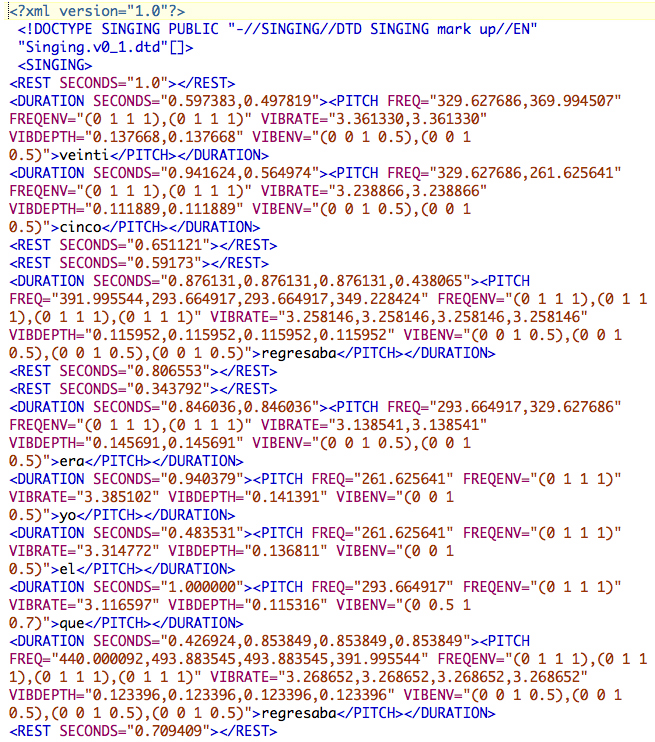Tropos (2005)
|
|||
site-specific sound installation |
 |
||
|
"Tropos" is a site-specific sound installation at the bathrooms of Centro Cultural de España en Buenos Aires (CCEBA). Based on the idea of anonymous sonic graffiti, the public restrooms at CCEBA are connected to Internet, allowing text messages to be sent from around the world using a public web site. Sent messages are sang in the restrooms by a computer agent which composes melodies according to their content and syntax.
|
|||
| Details | |||||
| Exhibited |
Centro Cultural de España en Buenos Aires (CCEBA), from September 14 to October 20, 2005. |
||||
Commission |
Commissioned by the Agencia Española de Cooperación Internacional (AECI). |
||||
Aesthetic Description |
The concepts of private and public space articulate in a very particular way in public restrooms, spaces of complex social relationships. We can conceive public restrooms as a space of anonymous communication, like in the old tradition of writing messages and phrases on their walls: the private graffiti. In "Tropos" the restrooms of CCEBA are connected to the Internet (virtual space where private and public data articulate with indifference). Using a public site, anyone can leave text messages (in Spanish or English) which get converted into sound and played through speakers installed in both men and women restrooms. These voices act as material "terminals" that emerge from the dematerialized virtual space of the Internet. Each message sent from the web site is sang in the restrooms by an electronic agent. The computer system assumes the embodiment of the the sender, randomly assigning him or her a voice and a melody which is algorithmically composed in real time. This way, the sender can choose to which bathroom (women or men) the message is sent, while her or his embodiment is in charge of the system. This systemic interface acts as a link between the immaterial and material worlds, as well as a transformation and distortion engine for the messages, introducing ambiguity and incertitude in their materialization as songs, as the genre of the avatar-singer and the melodic line imposed to the text can deeply alter their meaning (messages can get sang by soprano, alto, tenor or bass voices). Finally, this work is also a sort of homage to a piece known as "El Baño" (originally the piece had no title) by Roberto Plate . This piece was presented as part of the "Experiencias 1968" exhibit at the Instituto Di Tella, which took place many years ago just a few meters away from CCEBA!. We could think that while Plate's piece was based on the idea of simulation, "Tropos" is a conceptual extension towards the idea of emulation, where Sound Art and Net Art combined create a new hybrid space (private/public, real/virtual) within the restrooms of CCEBA. |
||||
Technical Description |
The system created for "Tropos" has two main components which are connected through the Internet. On one side, a web server running PHP and SQL hosts the Tropos web site located in DXARTS (Seattle), which gathers messages left online, filters their ASCII data, and stores each message into a data base, keeping information about the destination bathroom (wether the sender picked the men's or women's room), and the selected language (wether the message was left in Spanish or English). Each message in the data base is also date- and time-stamped; during the month the piece was online over a thousand messages were left at the site. On the installation side at CCEBA (Buenos Aires), the client software queries messages from the server with a PHP interface, using statistical rules based on the gender, language, and date of messages. Using the Scheme programming language, retrieved text data is then parsed to find particular inflections, different types of pauses, and special words, organizing the text into phrases of different length and variable degrees of expression. Once parsed and organized, the text is used to algorithmically compose a song, mapping a melodic contour to each phrase, combining syllabic and melismatic singing (depending on expression degrees defined in the parsing step). The output of this algorithm is a XML score used to run a custom designed vocal synthesizer developed using the Festival speech synthesis language. Rendered messages are then scheduled for playback, this is done using the SuperCollider sound processing and synthesis language. The algorithm plays back the message at the selected bathroom; the electronic sound is digitally reverberated to transform the acoustics of the site in order to create the illusion of voices singing in a small chapel. Also, part of the reverberant field is sent to the adjacent bathroom to emphasize a feeling of "leakage", turning the wall separating the two bathrooms into an acoustic membrane by letting some of the singing happening on the other side be heard but with a blurred and distant quality, which usually turns messages unintelligible. |
||||
Credits |
Center for Digital Arts and Experimental Media (DXARTS), University of Washington. |
||||
| Documentation | |||||
Diagram |
| ||||
[1] System block diagram [2] Excerpt of algorithmically generated XML code used to control the vocal synthesizer. |
|||||
Video |
Video excerpt from "Anfibios" TV show (by Ciudad Abierta, Buenos Aires) |
||||
Audio |
Sound recording done at women bathroom Sound recording done at men bathroom |
||||
© 2007-2010 Juan pampin, All Rights Reserved. |
|||||

